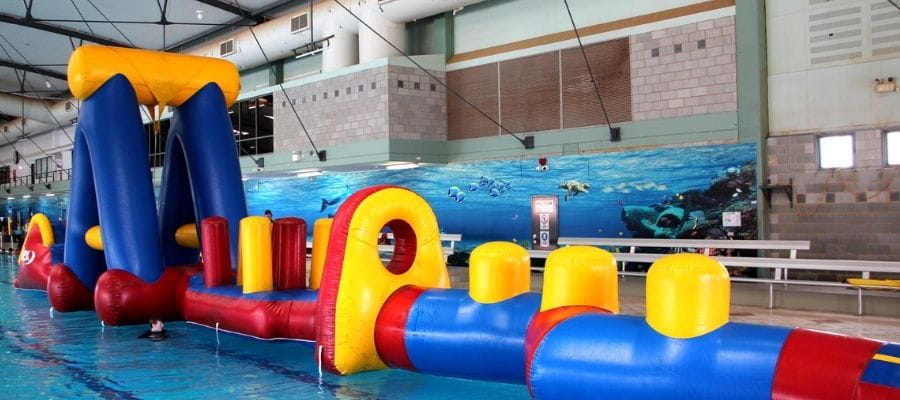
Giant inflatable devices are a popular attraction at public swimming pools, but the 2021 tragedy in Davonport, Tasmania involving a jumping castle has highlighted concerns around the risks of use in outdoor pools.
In order to protect against the inflatable becoming airborne, it is best to focus on anchorages.
Guidance
The current Australian Standard for Amusement rides and devices, Specific requirements – Waterborne inflatables (AS 3533.4.5-2017) contains the following direction for external use when exposed to wind (section 5.2.1).
- Where the inflatable is required to withstand wing pressure, each anchorage point on the inflatable and on the pool edge shall withstand a minimum horizontal force of 1.6kN (160 kgf) and shall be tested as such.
- Each anchorage rope of strap and associated fittings shall have a minimum breaking load of 8kN.
- Anchorage ropes and/or straps that may be fallen on shall be braided polyester, UV protected, smooth, padded where necessary, brightly coloured and incorporate an expansion piece to allow some flexibility. The expansion piece shall be installed in parallel with the anchor rope for a sufficient length such that after maximum 500 mm of stretch the anchor rope takes the full load with no further stretch.
- Inflatables with an entry point from the edge of the pool shall not include an expansion piece in the anchorage at the entry point.
- The anchorage system shall be designed so that the anchor or ropes or straps, incorporating an expansion piece where required, are secured in a manner that prevents the device lifting off the water or moving from the designation operating position. (Note: Expansion piece should have a maximum stretch of 500 mm and a minimum breaking load of 0.25 kN (25 kgf).
- Anchorage systems shall incorporate attachment methods that follow recognized rigging practice. (Note: Anchor ropes should sufficiently in tension to hold the device in the designated operations position during use).
The standard provides limits within inflatables should stay when setting up and operating in windy conditions as well as methods to calculating the number of anchorage points required to address wind loads.
Inspections
Regular inspections are required as a part of the standards. This includes daily inspections of all anchorage system components and an annual inspection in line with AS3533.2 and AS3533.3. These inspections should include:
- the anchor system for wear, rips or chafing
- the type and number of anchors or ballasts for conformity with the design specifications
- the existence of a hazard identification and risk assessment
- staffing procedures including training and the number of lifeguards required to supervise the inflatable when in use
Royal Life Saving recommends for owners and operators of inflatables to ensure they have access to and operate in line with the standard. It can be accessed here at the Standards Australia website.
Royal Life Saving WA can provide advice, assistance or support in preparing or reviewing a risk assessment by contacting the Safe Venues team at (08) 9383 8200.